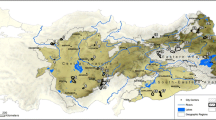Abstract
Tropical deforestation has emerged as one of the most important conservation challenges of our time, both because of the high species diversity and rates of endemism of tropical forests, and because of the rapid rate at which this process is proceeding. Recent studies indicate that areas of low-intensity agroforestry have similar levels of vertebrate diversity as some primary habitats, leading some researchers and conservationists to conclude that this type of commodity production could contribute to the conservation of biodiversity. We compared the composition of bird, mammal and herpetofaunal communities in primary forest, secondary forest, and pasture—and within the allspice productive systems that have replaced pasture. We found that mammal species richness was higher in primary forest than all other habitats; however for resident and migrant birds, amphibians and reptiles, species richness was similar between primary forest and the other habitats. Despite similarities in overall numbers of species, there were numerous species that were encountered only in primary habitats. We conclude that the cultivation of allspice in a mixed productive system can offset some of the losses to biodiversity; however it should be complemented by the establishment and maintenance of protected areas to accommodate populations of primary forest specialists that are unable to persist in altered habitats.
Similar content being viewed by others
References
Daily GC, Erlich PR (1996) Global change and human susceptibility to disease. Ann Rev Energy Environ 21:125–144
Daily GC, Ceballos G, Pacheco J (2003) Countryside biogeography of neotropical mammals: conservation opportunities in agricultural landscapes of costa rica. Conserv Biol 17:1814–1826
Donald PF (2004) Biodiversity impacts of some agricultural commodity production systems. Conserv Biol 18:17–37
Estrada A, Coates-Estrada R, Meritt DA (1997) Anthropogenic landscape changes and avian diversity at Los Tuxtlas, Mexico. Biod Conserv 6:19–43
Global Environment Facility (1997) Atlantic Biological Corridor Project, Nicaragua. Report No: 16535-NI World Bank, Washington, DC
Gotelli NJ, Entsminger GL (2001) EcoSim: Null models software for ecology. Version 7.0. Acquired Intelligence Inc. & Kesey-Bear. http://www.homepages.together.net/∼gentsmin/ecosim.htm. Accessed July 2004.
Greenburg R, Bichier P, Angon AC, Reitsma R (1997a) Bird populations in shade and sun coffee plantations in central Guatemala. Conserv Biol 11:448–459
Greenburg R, Bichier P, Sterling J (1997b) Bird populations in rustic and planted shade coffee plantations in eastern Chiapas, Mexico. Biotropica 29:501–514
Greenberg R, Bichier P, Angon AC (2000) The Conservation value for birds of cacao plantations with diverse planted shade in Tabasco, Mexico. Anim Conserv 3:105–112
Heinen JT (1992) Comparisons of the leaf litter herpetofauna in abandoned cacao plantations and primary rain forest in Costa Rica: some implications for faunal restoration. Biotropica 24:431–439
Hughes JB, Daily GC, Ehrlich PR (2002) Conservation of tropical forest birds in countryside habitats. Ecol Lett 5:121–129
Karr JR (1981) Surveying birds with mistnets. In: Ralph CJ, Scott JM (eds) Estimating numbers of terrestrial birds. Studies in Avian Biology 6, pp 62–67
Kamaljit SB, Seidler R (1998) Natural forest management and conservation of biodiversity in tropical forests. Conserv Biol 12:46–55
Laurance WF, Cochrane MA (2001) Synergistic effects in fragmented landscapes. Conserv Biol 15:1488–1489
Marra PP, Sherry TW, Holmes RT (1993) Territorial exclusion by a long-distance migrant warbler in Jamaica—a removal experiment with American Redstarts (Setophaga ruticilla). Auk 110:565–572
Moguel P, Toledo VM (1999) Coffee cultivation and biodiversity conservation. Conserv Biol 13:11–21
Naidoo R (2004) Species richness and community composition of songbirds in a tropical forestagricultural landscape. Anim Conserv 7:93–105
Perfecto I, Mas A, Dietsch T, Vandermeer J (2003) Conservation of biodiversity in coffee agroecosystems: a tri-taxa comparison in southern Mexico. Biod Conserv 12:1239–1252
Rappole JH (1995) The ecology of migrant birds: a Neotropical perspective. Smithsonian Institution Press, Washington, DC
Rappole JH, Ramos MA, Winker K (1989) Winter wood thrush movements and mortality in southern Veracruz. Auk 106:402–410
Rappole JH, Winker K, Powell GVN (1998) Migratory bird habitat use in southern Mexico: mist nets versus point counts. J Field Ornithol 69:635–643
Rappole JH, King DI, Vega Rivera JH (2003a) Coffee and conservation. Conserv Biol 17:334–336
Rappole JH, King DI, Vega Rivera JH (2003b) Coffee and conservation III; a reply to Philpott and Dietsch. Conserv Biol 17:1847–1849
Reitsma R, Parrish JD, Mclarney W (2001) The role of cacao plantations in maintaining forest avian diversity in southeastern Costa Rica. Agroforest Syst 53:185–193
Rice RA, Greenberg R (2000) Cacao cultivation and the conservation of biological diversity. Ambio 29:167–173
Smith JH (2003) Environmental assesment: land-cover assessment of conservation and buffer zones in the BOSAWAS natural reserve of Nicaragua. US EPA Landscape Characterization Branch E243-05; DOI: 10.1007/s00267-002-2774-8
Tejeda-Cruz C, Sutherland WJ (2004) Bird responses to shade coffee production. Anim Conserv 7:169–179
Winker K, Rappole JH, Ramos MA (1990) Population dynamics of the Wood Thrush in southern Veracruz, Mexico. Condor 92:444–460
Wunderle JM, Latta SC (1996) Avian abundance in sun and shade coffee plantations and remnant pine forests in the Cordillera Central, Dominican Republic. Ornitol Neotrop 7:19–34
Acknowledgements
Funding for this project was provided through the Global Environmental Facility and the Environmentally & Socially Sustainable Development Sector Management Unit, Latin America and the Caribbean Region of the World Bank. The authors would like to thank the members of CoopeSiuna Cooperative and the Programa Campesino a Campesino of La Unión Nacional de Agricultores y Ganaderos (UNAG) for field help and logistical support. The manuscript benefited from the comments of J. Wunderle and S. Sillett. R. Chaverri assisted with data summary and analysis.
Author information
Authors and Affiliations
Corresponding author
Rights and permissions
About this article
Cite this article
King, D., Hernandez-Mayorga, M., Trubey, R. et al. An Evaluation of the Contribution of Cultivated Allspice (Pimenta Dioca) to Vertebrate Biodiversity Conservation in Nicaragua. Biodivers Conserv 16, 1299–1320 (2007). https://doi.org/10.1007/s10531-006-9068-z
Received:
Accepted:
Published:
Issue Date:
DOI: https://doi.org/10.1007/s10531-006-9068-z




